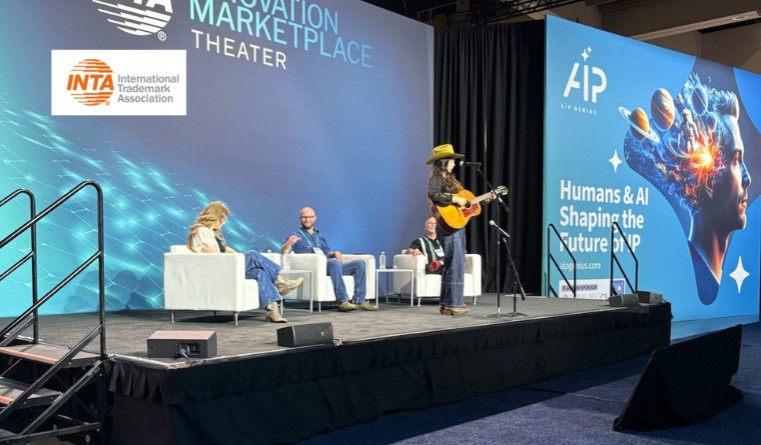It’s no secret that generative AI poses challenges for the music and other creative industries. Experts discussed those challenges and opportunities at a session of the INTA 2025 Annual Meeting called The Business of Music: IP, AI, and the Future of Creativity.
“Right now, [generative AI challenges] everything, said Carter Brallier, a Nashville-based musician. “You have instrument makers, studio musicians, sound engineers, recording studios. It’s the whole ecosystem and generative AI has this effect on it all, where you are not able to bring in that individual voice that you have, and when that’s taken away, it affects everybody in the industry.”
Brallier mentioned streaming fraud on music platforms, where bots or other automated methods artificially inflate certain songs – often AI-created songs – at the expense of human-created songs, thereby depriving human creators of income. “If you’re listening to Spotify and see a Humanable logo next to a song, you know it’s not generative AI. There are so many generative bands right now that are getting millions of plays that are taking away those of us actually doing the work.”
Lili McGrady, co-founder and president of Humanable, a certification mark launched to certify music as generative-AI free, says that efforts brought forth by her company could lead to consumers becoming more aware of when the music they enjoy is created by generative AI. She noted that the company is not anti-AI, but is, instead, pro-human music. McGrady was the session moderator.
“It’s been scary,” said Brallier. “I’m a bass player. That’s my bread and butter. When you take the individual out of art, it’s a scary thing. There are things that can’t be created. Let’s say you’re listening to The Beatles and you hear their first record, then you hear Rubber Soul, then you hear Sgt. Pepper’s, you can hear the growth of somebody through experience, through their own lives. When you take that away, it’s a bummer. What [Humanable] is doing is helping us.”
J. Scott Evans, a lawyer and intangible asset director and founding partner at Stobbs, a global intangible asset management company, said that “everybody needs to understand that generative AI is here, and it is here to stay.”
Evans noted a recent preliminary report on fair use and generative AI from the United States Copyright Office in which, for the first time, the copyright office took a position on the controversial matter. “They said ‘we think, in certain situations it’s fair use and in other situations it’s not.’ Two days later, Donald Trump fired the head of the copyright office, so I’m fairly certain the final report is not going to align with the preliminary report.”
Evan said that Congress is “so concerned that [the United States] is going to be surpassed by China with the development of generative AI that it is going to write an explicit exception into the statute. They are very concerned. We need to realize it’s here and find innovative solutions to protect creatives in a world where AI and generative AI are going to be the future.”
When Evans was senior director IP and advertising law and Adobe, he was involved in a programme to identify content which had been created or edited by generative AI.
“We made tools that are used to make deep fakes, [so] we set up a content authenticity initiative, which is a way to identify digital media – music, film, photographs – that have been edited or have generative AI. Then we worked with other companies to form the Coalition for Content Provenance and Authenticity, C2PA.”
Evans said that C2PA has developed an open-source, free standard that will attach a label – he likened it to the nutrition labels we all know – that provides a background of when the content was created, when and how it was edited and whether it contains generative AI.
Evans noted that computers and software have made it significantly easier to copy content created by others. “Twenty years ago, it took a lot of talent to create something that looked like someone else’s art. Today, you just have to be able to type.” To combat this, Evans put together the Protection Against Digital Replica Abuse Act (PODRA), which has been introduced in Congress as an amendment to U.S. copyright law. “I took the approach that style is similar to trade dress. If you are able to prove that people in the trade recognize your style, and it is being aped and commercialized by someone, [that use] should be penalized.”
Evans suggested that many of the problems involving media today could be resolved by the companies that control the rights to the media, in part because they are still using distribution models that were developed in the 1930s. Imagine, he said, living in London and watching your favourite shows on Netflix, then going on holiday to Spain, where suddenly your favourite shows were no longer available. “They’re facing a generation that wants any content on any screen at any time. You now have people using illegal VPNs so they can watch their shows. I’ve said to the content industry for years that iTunes is an example that if you give the consumers what they want, 90 percent of the consumers will go to the legal choice. Content folks need to get with the programme.”
- Gregory Glass, reporting from San Diego







